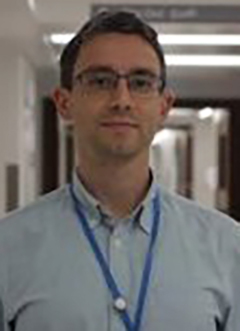Felice D’Arco1, Annabel Liao2
1Great Ormond Street Hospital for Children NHS Foundation Trust, London, UK; 2TP Editorial Office, AME Publishing Company
Correspondence to: Annabel Liao. TP Editorial Office, AME Publishing Company. Email: editor@thetp.org.
Editor’s note
Translational Pediatrics (TP) has published a number of special series in recent years, receiving overwhelming responses from academic readers around the world. Our success cannot be achieved without the contribution of our distinguished guest editors. This year TP launched a new column, "Interviews with Guest Editors", to better present our guest editors and to further promote the special series. We also hope to express our heartfelt gratitude for their tremendous effort and to further uncover the stories behind the special series.
The special series "Pediatric Neuroradiology for Trainees and Fellows: An Updated Practical Guide" (1) led by Dr. Felice D’Arco (Figure 1) from Great Ormond Street Hospital for Children NHS Foundation Trust has attracted many readers since its publication. This series was conceived as a practical paediatric neuroradiology guide for trainees and fellows with introductive papers from experts about the basic approach to different fields of the fascinating area of paediatric radiology. At this moment, we are honored to have an interview with Dr. D’Arco to share his scientific career experience and insights on this special series.

Figure 1 Dr. Felice D’Arco.
Expert introduction
My name is Felice D’Arco, and I am a paediatric neuroradiologist at Great Ormond St hospital for children in London UK, which is one of the biggest hospitals in the world. I am originally from Italy where I did most of my training before moving to Belgium for an internship in advance neuroimaging techniques and, subsequently, Toronto for a fellowship in paediatric neuroradiology.
I am passionate about research and teaching, and I am a teacher of neuroradiology for the European Society of Neuroradiology, European Society of Head and Neck Radiology, European Society of Paediatric Radiology and Italian Society of Neuroradiology.
My hobbies are literature, art and fitness.
Interview
TP: What motivated you to specialize in paediatric neuroradiology?
Dr. D’Arco: I think that this specific field is particularly interesting for the variety of diseases and complex syndromic association that makes it unique and extremely challenging. Advanced imaging techniques, genetic knowledge and fine radiological pattern recognition are essential ingredients for a successful career in this field and it makes a tangible impact in children life every day.
TP: Thank you for editing the special series "Pediatric Neuroradiology for Trainees and Fellows: An Updated Practical Guide" (1) for TP. Which part of the content impressed you most in this special series? Compared with other similar projects, what do you think are the unique advantages of this special series?
Dr. D’Arco: The focus of this special series was to keep the information on a very practical level and make these papers to be, rather than advanced, helpful in the daily clinical practice of radiologists non-specialised in pediatric neuroimaging.
TP: You mentioned what happened at the first night you became a neuroradiology fellow in Toronto SickKids hospital in "Editorial: a practical paediatric neuroradiology guide for trainees and fellows" (2) of this special series. As you are experienced in paediatric neuroradiology, do you have any other cases that are particularly impressive to you? Could you share one or two with us?
Dr. D’Arco: I think that, rather than one single case, I need to stress the importance of the multidisciplinary discussion in paediatric neuroscience. I've seen in numerous cases how the collaborative effort with paediatric neurologists, neurosurgeons, neuro-oncologists and nurses will literally change the course of the disease for numerous children and impact the life of their families. In this sense, pediatric neuroradiology is a field that makes you feel, as radiologist, helpful and that you are making an impact every day.
TP: Looking towards the future, what do you believe is the most important direction for the study of pediatric neuroradiology?
Dr. D’Arco: I think the most important future development will be translational research applied to pediatric neuroimaging, in particular the use of artificial intelligence methods and advanced techniques under strict clinical and human supervision. In other words, the game changer will be to take the best out of these new techniques keeping a clinical guidance focused on the patients’ prospective and benefits.
TP: Do you have any suggestions for young fellows who want to specialize in pediatric neuroradiology?
Dr. D’Arco: I think it's very important to use the numerous sources of knowledge available online, I myself have a YouTube channel dedicated to paediatric neuroimages with the only goal to share knowledge in this specific field (https://www.youtube.com/@FeliceDArcoPedNeuroRad/videos).
Also, a pediatric neuroradiology dedicated fellowship is critical in my opinion.
TP: If given an opportunity to update this special series, what would you like to moderate, add or emphasize to provide a more comprehensive series?
Dr. D’Arco: I think I would use a "pattern recognition pictorial essay approach" to just show typical and relevant pediatric neuroradiology cases that you can encounter in your daily radiology life!
Reference
- Pediatric Neuroradiology for Trainees and Fellows: An Updated Practical Guide. Available online: https://tp.amegroups.com/post/view/pediatric-neuroradiology-for-trainees-and-fellows-an-updated-practical-guide.
- D’Arco F. Editorial: a practical paediatric neuroradiology guide for trainees and fellows. Transl Pediatr 2021;10(4):1063-1064. doi: 10.21037/tp-21-91.
